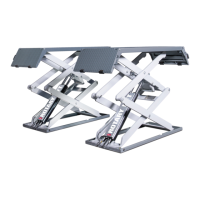35
9.4 Approved hydraulic oils
Important information
•
Only use hydraulic oils in accordance with DIN
51524 for the hydraulic system.
•
Only use biodegradable oils
(HEES-based on synthetic esters).
•
Use PTFE seals or foam elastomers if the water
content is high.
Seals may be destroyed if the
incorrect hydraulic oil is used.
Do not use rapeseed based oils.
The water content of the hydraulic oil must
not exceed 2%.
Do not mix bio-oils with mineral oils. Mixing
leads to foaming problems and corrosion
damage.
Make sure that the oil is not contaminated
by any other oil or water.
Use a proportionally lower viscosity bio-oil
as a replacement for mineral oil. This
improves the lubrication properties, reduces
energy consumption and generates less
heat.
HEES32-bio-oils can, for example, be used as a
replacement for mineral oil HLP46:
•
PLANTOSYN 3268
•
BECHEM HYDROSTAR HEES 32
•
BP Biohyd 32
•
Mobil EAL Hydraulic Oil 32
Oils and grease
Only use consistency classication II oils
and grease.
Water pollutants
Oils and grease are water pollutants in terms
of the Water Management Act (WGH).
Always dispose of these in an environment-
ally friendly manner in compliance with the
applicable regulations in your country
( → Chapter 14. Disposal).
9.5 Check, rell, change the hydraulic
oil
Risk to people and the environment
from toxic substances when lling
the hydraulic oil tank.
Avoid contact with and inhalation of
hydraulic oil.
Wear protective clothing (protective
goggles, protective gloves).
Provide suitable oil drain pans and oil abso-
rbents.
Ensure that no hydraulic oils, lubricants, or
cleaning materials contaminate the soil or
leak into the drainage system.
Comply with local regulations for handling
water pollutants, for example for absorbing
leaking uids or uids from oil separators.
Hydraulic oil is highly inammable, combu-
stible.
1. Open the cabinet and Check hydraulic oil level
on the hydraulic oil tank.
The oil level must not exceed the minimum
value ("min“).
2. Place the oil drain pan under the tank, remove
tank cap and rell hydraulic oil to the "max“mark.
3. Ensure that the vents work and that no vacuum is
generated.
4. Screw on the tank cap so that the tank is properly
sealed.
5. Remove oil residues on the oor or on the lift with
an approved detergent. Dispose of used cleaning
cloths in the correct manner.
6. Complete a maintenance report ( → Annex).
An oil change is carried out depending on
the extent to which the hydraulic oil has
degraded. To do so, proceed as follows:
1. Lower platforms completely, turn main switch off
("OFF“ position) and lock it.
2. Open the cabinet and Place the oil drain pan
under the hydraulic oil

